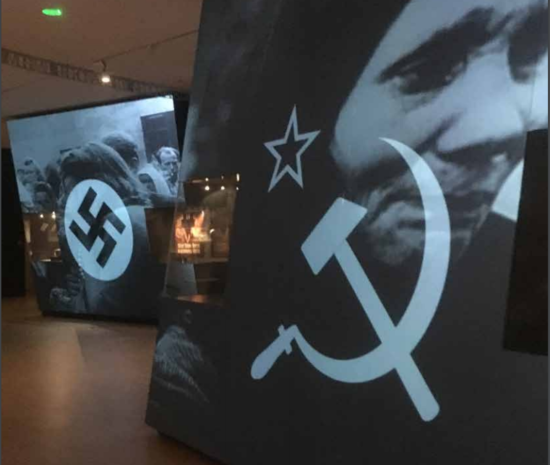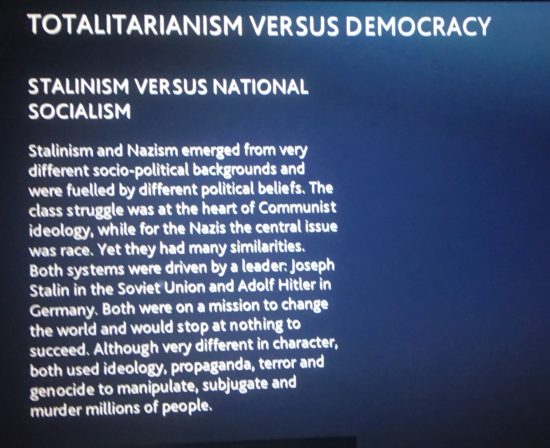OPINION | MUSEUMS | PRAGUE PLATFORM | EU | BELGIUM
◊
by Tord Björk
The Nazis wanted to exterminate a race and Karl Marx wanted to exterminate a social class. Our guide at the House of European History museum (HEH) in Brussels is twisting her tongue as she tries to solve the task of simultaneously explaining that Communism and Nazism are the same thing, and yet, somehow not. Visually, the impression of the museum’s exhibition is overwhelmingly slanted toward the notion that they are fully, inexorably and inherently equivalent.
Towering above us in the ideologically most intense part of the museum are huge video screens tilted towards the visitor. These screens, on four islands in the room, are so large that in spite of the hall being generously spacious, they fill up the room. The spectator can feel small in their shadow. On the screens the masses march in honor of the dictator, people are violently oppressed and the imagery makes this museum’s point very clearly: the interwar period was marked by the very same conflict as that after the war until the Soviet Union collapsed and the Berlin wall fell. That single conflict that is posited as God’s-honest-truth-fact is between Western democracy and (any kind of) totalitarianism. The technically impressive format is meticulously balanced: two huge screens each for the horrific methods of Communism and Nazism. The similarity is indeed visually striking. Stalin and Hitler—in that order— are omnipresent in the midst of terror. As a climax, the hammer and the sickle are projected at the same time as the swastika in meticulously equal format.
The first time I visited the museum I was very surprised. The emphasis that the official guide gave to a group that followed her was that the elimination of social classes and the extermination of Jews are equally abominable. But if this was the case, then a renunciation of the French Revolution’s abolition of nobility as a class, and the liberal revolution against feudal society’s lordly classes might also be up there.
See DH’S page on Red-Brown Iconography. Usually in Eastern Europe. Now in Brussels.
The second time I went around the museum with their headphones on. Suddenly, symbols of Communism and Nazism are illuminated at the same time. Always together. The voice clearly stated that the two ideologies were perhaps different, something that the guide also pointed out, but in practice the next moment the voice, like the guide, spoke against itself proclaiming them equally genocidal. A contradiction in practice which also to a large extent is given by HEH’s overall picture by texts and images throughout.
In the book on sale at the museum (and far beyond), Creating the House of European History, it is emphasized that one of “the most valuable tools for a historical museum’s narrative is audiovisual products.” But it also says that one must be extremely careful when using them. But HEH is doing the opposite by using this tool with a clear partisan political agenda, to rewrite history hiding behind emotive visual effects while omitting the kinds of of intellectual arguments that provide visitors with more than one opinion. This museum’s narrative is clearly based on the East European far right’s revisionism. That World War II and its genocide were the result primarily of Fascist aggression, not of equal oppressive Fascist and Communist aggression combined against democracies, is a long-held consensus, as it happens, of the very democratic free world that the museum so idealizes and idolizes.
What the curators of this museum have done is a manipulation of the craft of the exhibition, the noble purpose of a museum altogether, as a tool for creating chronological and thematic exhibits that enable understanding of history, indeed presenting diverse viewpoints where appropriate, and where possible with the aid of visual and audiovisual means to illuminate the debate and encourage some free thinking among the visitors.
The new museum cost 50 million euros even before it opened on May 6, 2017, just behind the EU Parliament building in Brussels. History revisionism has here been given one of its most costly and clear expressions with the expensive and apparently uncritically expansive help of the European Union.
The racist world order and the Western European (yes, European) colonial and neocolonial relations with the rest of the world are wiped out of history altogether. Western democracies are instead given a pure, heroic role retrospectively applied over their entire histories. Coming to history of the war, you would never know from this museum that it was principally thanks to the Soviet Union, for all its evils, that Nazism was defeated in the east, in the period between 1941 and the Normandy landings three years later, after millions of Soviet lives had been sacrificed during the years of the British-American-Soviet alliance (with no diminution of Stalin’s horrific crimes or the need for them to be included in the narrative).
History revisionism, presented as ultimate truth rather than a viewpoint, replaces the common view of history by a new one where democratic liberalism is opposed to two equal aggressive totalitarian regimes.
The House of European History is the foremost recent expression of this followed by the resolution on the European Parliament of 19 September 2019 on the “Importance of European Remembrance for the Future of Europe” and the ongoing polarization on rewriting of history. This document casually cites among its authoritative antecedents the 2008 Prague Declaration that has become a kind of “constitution” for the movement to equalize Nazi and Soviet crimes.
Here’s how the exhibition describes the view of the world.
“Stalinism and Nazism emerged from very different socio-political backgrounds and were fuelled by different political beliefs. The class struggle was at the heart of the communist ideology, while for the Nazis the central issue was race. Yet they had many similarities. Both systems were run by a leader: Joseph Stalin in the Soviet Union and Adolf Hitler in Germany. Both were on a mission to change the world and would stop at nothing to succeed. Although very different in character, both used ideology, propaganda, terror and genocide to manipulate, subjugate and murder millions of people.”
It is therein taken a a given that genocide is an accepted facet of Nazi and Soviet crimes (so much for the appreciation of what the Holocaust actually was…).
Curiously, the House of European History in Brussels has received a most thorough criticism from the Platform of European Memory and Conscience, itself a history-revisionist unit. A detailed report states that the exhibition provides a “Marxist interpretation of history” beginning with the French Revolution, followed by revolutions towards a classless society. Criticism towards communism is diminished, according to these critics, because the totalitarian ideology that is compared to (or equated with) Nazism is not Communism in general but Stalinism. The end of the Cold War with the liberation of Eastern Europe is not presented as the greatest victory against totalitarianism after World War II. Like many others, their criticism also points out that nationalism is portrayed as the main cause of Europe’s plagues. The character of the Platform and its reactionary history revisionism, funded by the EU, becomes specifically clear when it is criticizes HEH for not adequately distinguishing, in its view, between fascism and Nazism.
From the left, criticism is also directed against both HEH and The Platform of European Memory and Conscience. Totalitarianism is seen as an obsolete explanatory model. It leads to simplified reasoning that both the Soviet Union and Germany carried out genocide while the particpation in the Holocaust by Nazi collaborators are eradicated. It is important, according to this left-wing approach, to give the victims of oppression and terror exerted by states governed by communist parties attention. But not in a way that reduces the specific nature of the Holocaust.
Nothing in this criticism leads forward or can solve the visual and other substantive contradictions created by HEH in the heart of European self-understanding. In its most extreme form, it leads to total collapse of the possibility of being able to understand the world through rationally founded visual methods. This happens when The Platform of European Memory and Conscience presents the Prague Declaration which is the foundation of this organization’s work. Here, the hammer and the sickle are completely brought together with the flag of Nazi Germany, the merger being as complete as when the Nazi party merges the hammer and the sickle with the star of David. This ideological platform was led by the Swedish Conservative politician Göran Lindblad from the start until two years ago. The circle is complete. text and image create a “whole” has got its clear expression here.
Unbeknowst to many, Sweden has played a central role in launching liberal history revisionism with its effective pedagogical methods and support from almost all political quarters and governmental aid. It should be examined least not from its domestic roots. It is of international interest as this rewriting of history has taken place simultanously with the launching of an ambitious attempt to emphasize the need to never forget the Holocaust and initiating the first International Forum on the Holocaust held in Stockholm in 2000.
That Sweden plays a crucial role in launching the neoliberal history revisionism with the help of a state authority can be seen as an expression of the consensus that existed for a long time. But it is contrary to a customary attitude in liberal Western countries that the state should not handle such tasks, which is also the reason why the Swdish FFLH lacks a counterpart in almost all other Western countries where corresponding institutions are instead subordinate to universities or independent organizations.
In addition, there are in Sweden unusually strong campaign organizations funded by business money. The Confederation of Swedish Enterprise allocated 320 million to various projects such as Timbro and also Information on Communism and later Free World Forum, all of them have been involved in neoliberal rewriting of history. The Information on Communism project became the most prominent in Western Europe that rallied behind Göran Lindblad’s Platform of European Memory and Conscience. Together with the Alliance Government with center-right parties, the 2014 Memorial Day for the Victims of Totalitarianism was announced on August 23. Sweden became the only country in Western Europe where the day was highlighted with governmental participation.
In real life, “Information on Communism” acts the same way as the Prague Declaration. They say they pay attention to victims of all forms of totalitarianism, but in practice exploit the uproar over historical Nazism to focus on what they see as most important, to denounce Communism while promoting the revised history that insists that they are equal evils.
In the summer of 2018, a temporary exhibition was held in the European Quarter in Brussels, which dealt with the propaganda of Nazism. There were many placards here that mainly showed the antisemitic expression of Nazism, but also some anti-communist expressions of the same, usually tied together by the Nazi regime. What was completely lacking, however, were indeed these propaganda images against “Jewish Bolshevism” even though they had a prominent place in Nazi Germany’s antisemitic imagination and propaganda. However, over time, this cohesive ideology is sorted out or the expert’s eye has lost the ability to look at the image he or she has in front of them.

